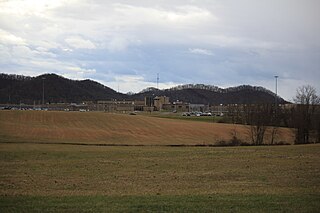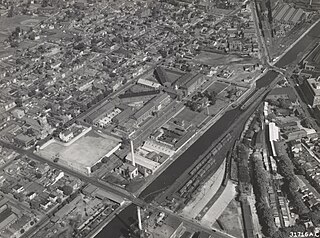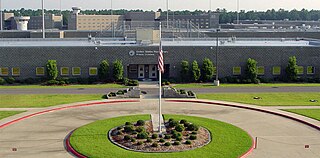
The Arkansas Department of Corrections (DOC), formerly the Arkansas Department of Correction, is the state law enforcement agency that oversees inmates and operates state prisons within the U.S. state of Arkansas. DOC consists of two divisions, the Arkansas Division of Corrections (ADC) and the Arkansas Division of Community Corrections (DCC), as well as the Arkansas Correctional School District. ADC is responsible for housing and rehabilitating people convicted of crimes by the courts of Arkansas. ADC maintains 20 prison facilities for inmates in 12 counties. DCC is responsible for adult parole and probation and offender reentry.

Capital punishment is a legal penalty in the U.S. state of Ohio, although all executions have been suspended indefinitely by Governor Mike DeWine until a replacement for lethal injection is chosen by the Ohio General Assembly. The last execution in the state was in July 2018, when Robert J. Van Hook was executed via lethal injection for murder.

The Federal Prison Camp, Alderson is a minimum-security United States federal prison for female inmates in West Virginia. It is operated by the Federal Bureau of Prisons, a division of the United States Department of Justice.
A reformatory or reformatory school is a youth detention center or an adult correctional facility popular during the late 19th and early 20th centuries in Western countries. In the United Kingdom and United States, they came out of social concerns about cities, poverty, immigration, and gender following industrialization, as well as from a shift in penology to reforming instead of punishing the criminal. They were traditionally single-sex institutions that relied on education, vocational training, and removal from the city. Although their use declined throughout the 20th century, their impact can be seen in practices like the United States' continued implementation of parole and the indeterminate sentence.
Elmira Correctional Facility, also known as "The Hill", is a maximum security state prison located in Chemung County, in the City of Elmira in the US state of New York. It is operated by the New York State Department of Corrections and Community Supervision. A supermax prison, Southport Correctional Facility, is located 2 miles (3.2 km) away from Elmira.

The New Jersey State Prison (NJSP), formerly known as Trenton State Prison, is a state men's prison in Trenton, New Jersey operated by the New Jersey Department of Corrections. It is the oldest prison in New Jersey and one of the oldest correctional facilities in the United States. It is the state's only completely maximum security institution, housing the most difficult and/or dangerous male offenders in the inmate population. NJSP operates two security units and provides a high level of custodial supervision and control. Professional treatment services, such as education and social work, are a priority at the facility. The Bureau of State Use Industries operated the bedding and clothing shops that were once located in Shop Hall at the facility. These industries have been relocated to South Woods State Prison.

The Southern Ohio Correctional Facility is a maximum security prison located just outside Lucasville in Scioto County, Ohio. The prison was constructed in 1972. As of 2022, the warden is Donald Redwood.
Edna Mahan Correctional Facility for Women is a prison facility for women of the state of New Jersey Department of Corrections, located in Union Township, Hunterdon County, New Jersey, near Clinton. Its official abbreviation is EMCFW. The facility was named for Edna Mahan, one of the first female correctional superintendents in the U.S.

The Oklahoma State Penitentiary, nicknamed "Big Mac", is a prison of the Oklahoma Department of Corrections located in McAlester, Oklahoma, on 1,556 acres (6.30 km2). Opened in 1908 with 50 inmates in makeshift facilities, today the prison holds more than 750 male offenders, the vast majority of which are maximum-security inmates. They also hold many death row prisoners.
The Oklahoma State Reformatory is a medium-security facility with some maximum and minimum-security housing for adult male inmates. Located off of State Highway 9 in Granite, Oklahoma, the 10-acre (4.0 ha) facility has a maximum capacity of 1042 inmates. The medium-security area accommodates 799 prisoners, minimum-security area houses roughly 200, and the maximum-security area with about 43 inmates. The prison currently houses approximately 975 prisoners. The prison was established by an act of the legislature in 1909 and constructed through prison labor, housing its first inmate in 1910. The facility is well known for the significant roles women played in its foundation and governance, most notably having the first female warden administer an all-male prison in the nation.
A prison nursery is a section of a prison that houses incarcerated mothers and their very young children. Prison nurseries are not common in correctional facilities in the United States, although prior to the 1950s many states had them and they are widespread throughout the rest of the world.

The Indiana Women's Prison was established in 1873 as the first adult female correctional facility in the country. The original location of the prison was one mile (1.6 km) east of downtown Indianapolis. It has since moved to 2596 Girls School Road, former location of the Indianapolis Juvenile Correctional Facility. As of 2005, it had an average daily population of 420 inmates, most of whom are members of special-needs populations, such as geriatric, mentally ill, pregnant, and juveniles sentenced as adults. By the end of 2015, the population increased to 599 inmates. Security levels range from medium to maximum. The prison holds Indiana's only death row for women; however, it currently has no death row inmates. The one woman under an Indiana death sentence, Debra Denise Brown, had her sentence commuted to 140 years imprisonment in 2018 and is being held in Ohio.

The Texas Department of Criminal Justice (TDCJ) is a department of the government of the U.S. state of Texas. The TDCJ is responsible for statewide criminal justice for adult offenders, including managing offenders in state prisons, state jails, and private correctional facilities, funding and certain oversight of community supervision, and supervision of offenders released from prison on parole or mandatory supervision. The TDCJ operates the largest prison system in the United States.

The Kentucky State Penitentiary (KSP), also known as the "Castle on the Cumberland," is a maximum security and supermax prison with capacity for 856 prisoners located in Eddyville, Kentucky on Lake Barkley on the Cumberland River, about 4.8 kilometres (3 mi) from downtown Eddyville. It is managed by the Kentucky Department of Corrections. Completed in 1886, it is Kentucky's oldest prison facility and the only commonwealth-owned facility with supermax units. The penitentiary houses Kentucky's male death row inmates and the commonwealth's execution facility. As of 2015 it had approximately 350 staff members and an annual operating budget of $20 million. In most cases, inmates are not sent directly to the penitentiary after sentencing, but are sent there because of violent or disruptive behavior committed in other less secure correctional facilities in the commonwealth. This was Kentucky's second penitentiary: the first was made uninhabitable from a flood in 1937.
Kentucky Correctional Institution for Women (KCIW) is a prison located in unincorporated Shelby County, Kentucky, near Pewee Valley, Kentucky, operated by the Kentucky Department of Corrections. Male and female inmates prior to 1937 had been housed at the Kentucky State Penitentiary in Frankfort

Kentucky State Reformatory (KSR) is a medium-security prison for adult males. The prison is located in unincorporated Oldham County, Kentucky, near La Grange, and about 30 miles (48 km) northeast of Louisville. It opened in 1940 to replace the Kentucky State Penitentiary in Frankfort after a flood damaged the original property. The current (2020) capacity of KSR is 1053 inmates.

The Oklahoma Department of Corrections is an agency of the state of Oklahoma. DOC is responsible for the administration of the state prison system. It has its headquarters in Oklahoma City, across the street from the headquarters of the Oklahoma Department of Public Safety. The Board of Corrections are appointees: five members are appointed by the Governor; two members are appointed by the President Pro Tempore of the Senate; and two members are appointed by the Speaker of the house of Representatives. The board is responsible for setting the policies of the Department, approving the annual budget request, and working with the Director of Corrections on material matters of the agency. T. Hastings Siegfried is the current chairman of the board. The director, who serves at the pleasure of the governor, is the chief executive of the department. The current director of Corrections is Scott Crow, who was appointed after Director Joe Allbaugh resigned his post on June 13, 2019. Crow was confirmed by the Oklahoma State Senate as director in May 2020.

The United States Penitentiary, Pollock is a high-security United States federal prison for male inmates in unincorporated Grant Parish, Louisiana. It is part of the Pollock Federal Correctional Complex and operated by the Federal Bureau of Prisons, a division of the United States Department of Justice. The facility also has an adjacent satellite prison camp for minimum-security male offenders.
The Central Mississippi Correctional Facility (CMCF) is a Mississippi Department of Corrections (MDOC) prison for men and women located in an unincorporated area in Rankin County, Mississippi, United States, between the cities of Pearl and Brandon. The 171-acre (69 ha) prison was, for a period of time, the only state prison to hold female prisoners in Mississippi, in addition to minimum and medium security male offenders. It operates as the female death row of the state.
Washington Corrections Center for Women is a Washington State Department of Corrections women's prison located in Gig Harbor, Washington. With an operating capacity of 740, it is the largest women's prison in the state and is surrounded by Washington State Route 16, and McCormick forest park. It opened 53 years ago in 1971, 82 years after statehood.












